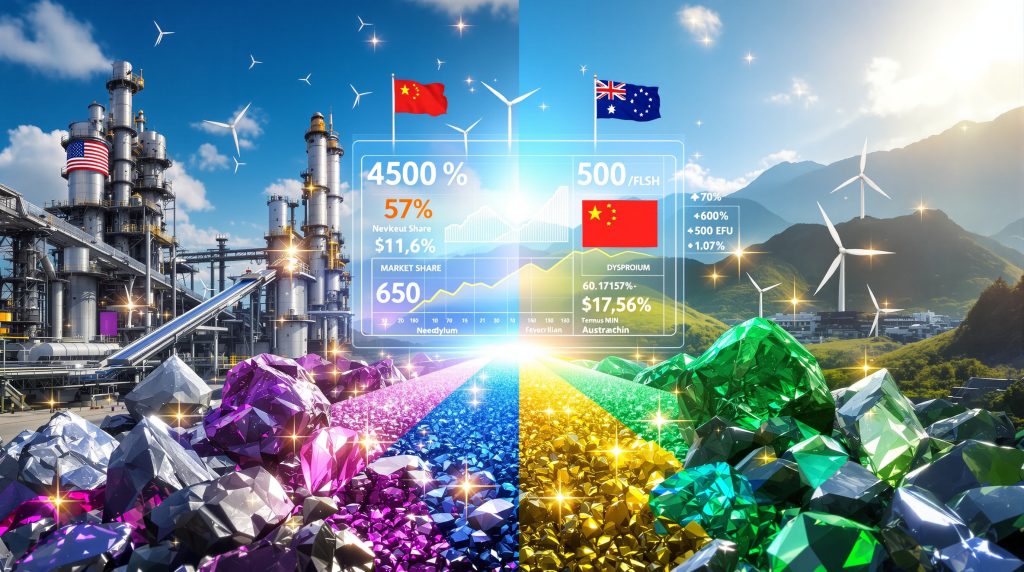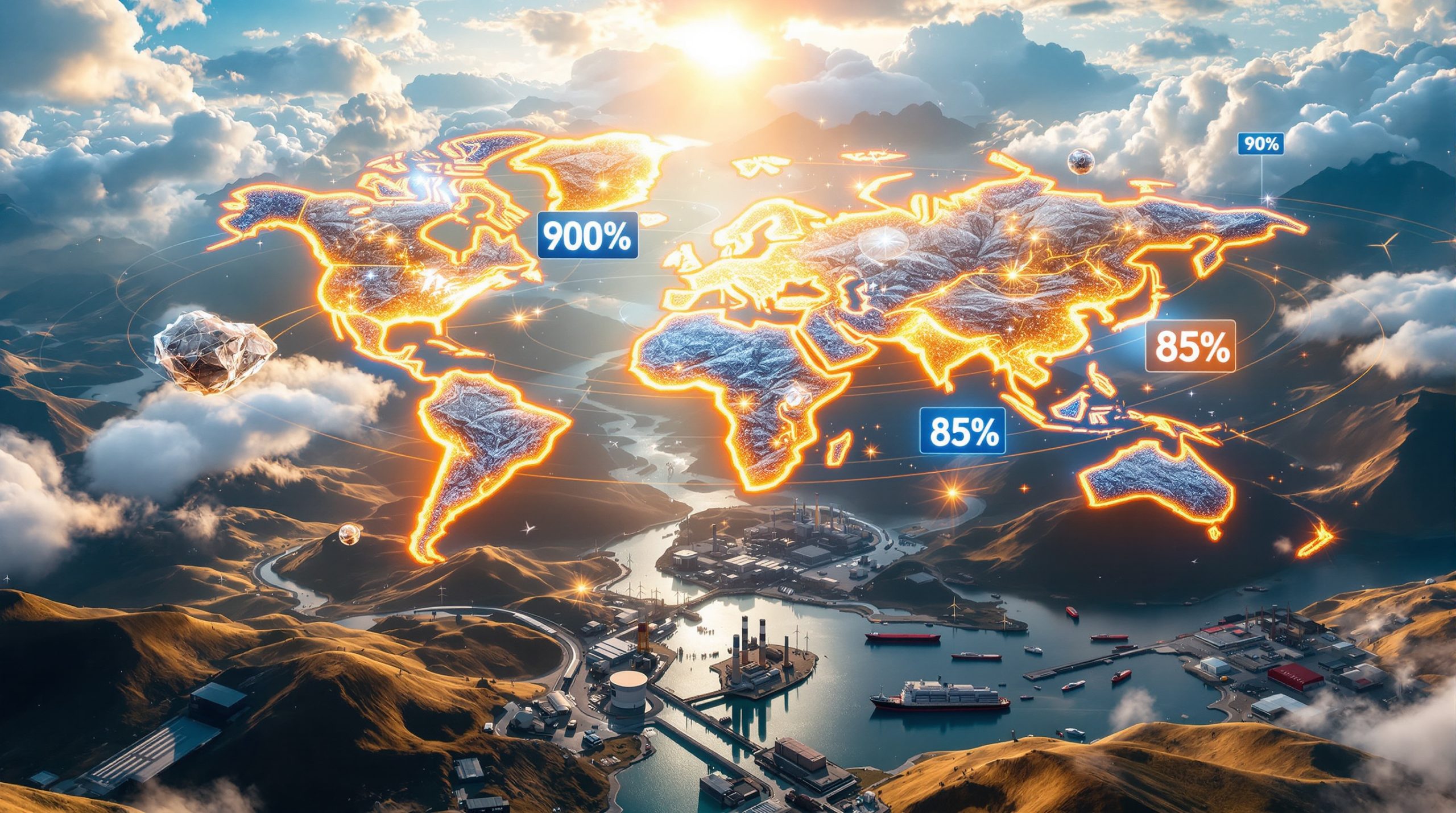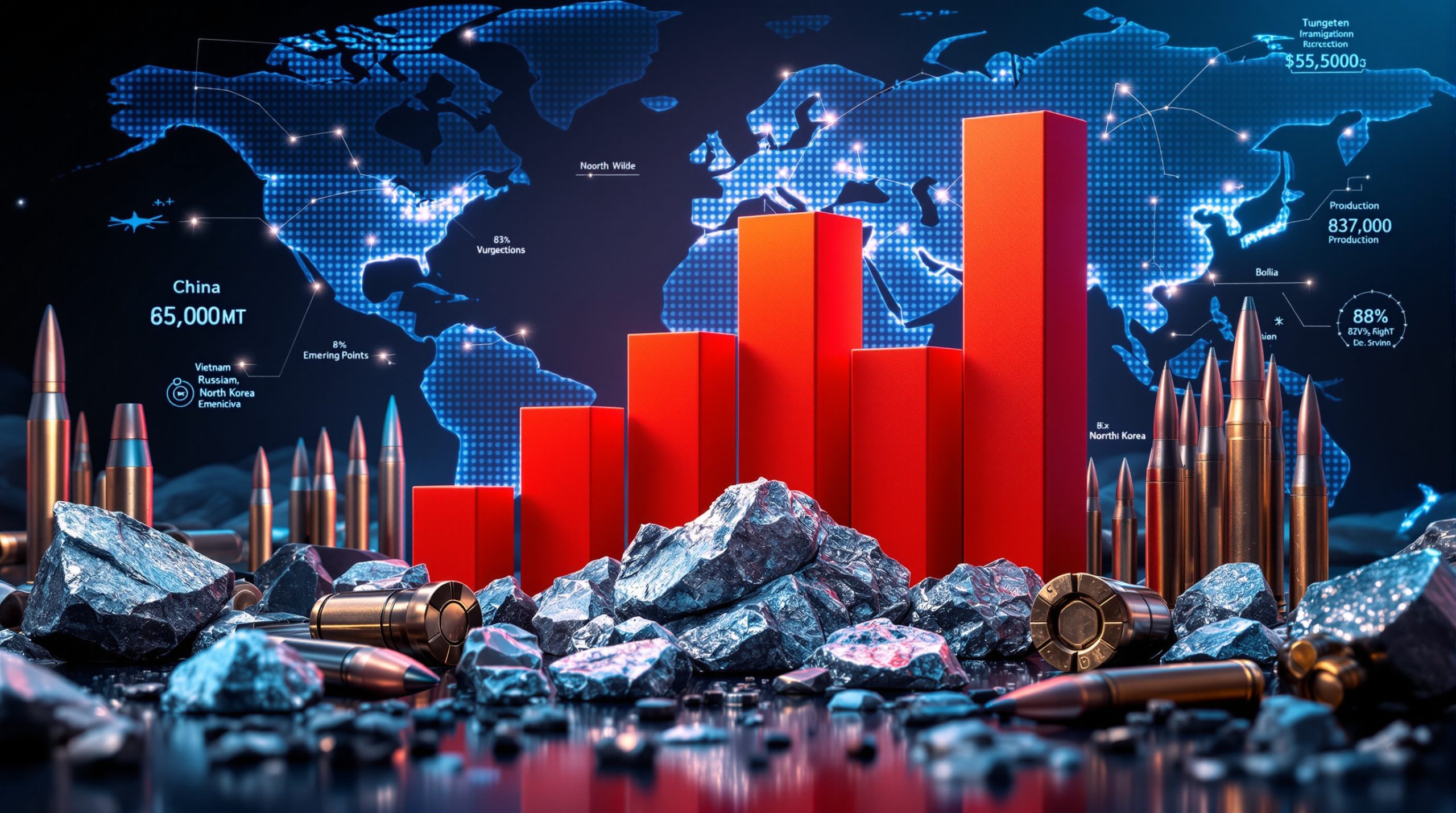The Critical Importance of Rare Earth Elements in Modern Industry
Rare earth elements represent seventeen specialised metals with unique magnetic, luminescent, and electrochemical properties that have become indispensable to modern technology. As rare earth producers look to US-led boom to blunt China's power, these materials enable the miniaturisation and efficiency improvements that define contemporary electronics, renewable energy systems, and defence technologies.
The global rare earth market reached approximately $6.5 billion in 2024, according to Goldman Sachs Group Inc., though this remains 33 times smaller than the copper market. Despite their relatively modest market size, these elements punch far above their weight in terms of strategic importance and economic impact.
Essential Applications Driving Global Demand
The applications for rare earth elements span across multiple critical sectors:
• Defence Systems: Precision-guided missiles, advanced radar systems, and fighter jet components rely heavily on rare earth magnets for their compact power and reliability
• Clean Energy Infrastructure: Wind turbine generators, electric vehicle motors, and solar panel inverters require these materials for optimal performance
• Consumer Electronics: Smartphone speakers, laptop hard drives, and LED displays depend on rare earth elements for their functionality
• Industrial Automation: Robotics actuators, precision machinery, and magnetic levitation systems utilise these materials for precise control
Market Growth Projections and Demand Surge
Industry analysts project dramatic expansion across key application sectors through 2033:
| Application Sector | Current Market Impact | Projected Growth |
|---|---|---|
| Electric Vehicles | Production disruptions at Ford and Tesla | 5x demand increase by 2033 |
| Wind Energy | Critical component shortages | Doubling of European demand |
| Consumer Electronics | Supply chain bottlenecks | 150% market expansion |
| Defence Applications | Pentagon investment surge | Strategic stockpiling initiatives |
China's Strategic Market Dominance and Control Mechanisms
China's overwhelming control of the rare earth industry stems from strategic decisions implemented during the 1980s when Beijing recognised the long-term value of these materials. The country systematically developed integrated supply chains spanning mining, refining, and manufacturing whilst Western nations focused on alternative industrial priorities.
Structural Advantages Maintaining Chinese Leadership
China's market position rests on several foundational elements that have enabled control over global rare earth reserves:
• Vertical Integration: Chinese companies control every production stage from ore extraction to finished magnet manufacturing
• State Support: Government subsidies, favourable regulations, and coordinated industrial policy provide competitive advantages
• Technical Expertise: Decades of accumulated knowledge in complex separation and processing techniques
• Cost Efficiency: Lower labour costs and historically relaxed environmental standards reduced production expenses
Export Control Implementation and Trade Restrictions
China unveiled supply restrictions in April 2025, expanding these measures in October to require export licences for items containing even trace amounts of certain rare earth elements. These controls specifically target heavy rare earth elements used as additives in magnetic materials to ensure performance at high temperatures.
The immediate impact of these restrictions proved severe. Following the April controls, Ford Motor Co. temporarily shut a Chicago factory after running short of rare earth components, whilst Tesla Inc.'s Optimus humanoid robot assembly also experienced disruptions. The European Union's Chamber of Commerce in China reported seven production stoppages at bloc companies in August 2025 alone.
Geographic Resource Distribution and Processing Bottlenecks
Whilst China holds approximately 50% of global rare earth reserves, its processing capacity represents over 85% of worldwide capability. This processing bottleneck means materials mined elsewhere often require Chinese facilities for refinement, creating dependencies that extend beyond raw material extraction.
Most concerning for Western supply chains is China's near-monopoly on heavy rare earth production, with most supplies coming from China or conflict-affected regions of neighbouring Myanmar before being refined in Chinese facilities. Furthermore, this concentration directly impacts critical minerals energy security for Western nations.
Western Strategic Response to Supply Chain Vulnerabilities
The recognition of rare earth supply chain risks has triggered unprecedented Western government intervention and investment, marking a departure from traditional market-driven approaches. In addition, rare earth producers look to US-led boom to blunt China's power through coordinated policy measures.
United States Government Investment Programs
The Pentagon's $400 million investment in MP Materials Corp. represents a landmark shift toward treating rare earth production as a national security priority. This funding model includes guaranteed minimum purchase prices and minimum volume commitments, effectively creating a protected market for domestic producers.
MP Materials operates America's sole rare earth mine and received this investment to fund magnet production expansion. The recent executive order on critical minerals has further strengthened government commitment to domestic supply chain development.
As CEO James Litinsky noted, the year has been characterised by intense activity and mounting pressure to deliver results.
Emerging US Production Infrastructure
Multiple magnet manufacturing facilities are advancing across the United States:
• Noveon Magnetics Inc. operates a Texas facility less than an hour from Austin, achieving commercial rare earth magnet sales since 2023 with current annual capacity of 2,000 tons
• USA Rare Earth Inc., Vulcan Elements Inc., Germany's Vacuumschmelze GmbH & Co. KG, and South Korea's JS Link Inc. are developing additional production facilities
• Cyclic Materials Inc., backed by Amazon.com Inc. and Microsoft Corp., aims to start producing magnet materials at a Canadian recycling facility in 2026
International Cooperation Frameworks
The recent bilateral agreement between Washington and Canberra establishes joint investment mechanisms for Australian mining projects and processing facilities. Both countries pledged to use trade protection measures like floor pricing to help ward off Chinese competition.
However, the broader US–China trade war impact on global supply chains has accelerated these diversification efforts beyond traditional allies.
As Nick Myers, CEO of Phoenix Tailings, explained, government backing significantly reduces investment risk: "By saying another group like the US government is there with big dollars, that de-risks the space significantly."
Production Challenges Facing Non-Chinese Producers
Western producers encounter substantial technical, economic, and supply chain obstacles in challenging Chinese dominance. Consequently, rare earth producers look to US-led boom to blunt China's power despite these significant hurdles.
Technical Complexity and Manufacturing Expertise
Rare earth magnet production demands precise control of chemical composition, temperature, and magnetic field orientation. As David S. Abraham, a professor at Boise State University, emphasised, "There's not a cookbook for magnet production. There's time needed to ensure the product you are selling to customers meets their exact specifications."
These processes require specialised equipment and expertise that Chinese manufacturers developed over decades. The technical knowledge gap represents one of the most significant barriers facing Western producers attempting to establish competitive operations.
Supply Chain Integration Difficulties
Western producers face the challenge of sourcing heavy rare earth elements, which remain predominantly controlled by Chinese suppliers. These materials serve as essential additives that enable magnet performance at elevated temperatures, making them critical for automotive and industrial applications.
Scott Dunn, co-founder of Noveon Magnetics, acknowledged the complexity: "You're dealing with requirements that are the result, in some cases, of decades of what China has delivered."
Economic Viability and Cost Competitiveness
| Cost Factor | Chinese Advantage | Western Challenge |
|---|---|---|
| Labour Costs | 60-70% lower wages | Higher skilled workforce requirements |
| Environmental Compliance | Historically relaxed standards | Strict regulatory frameworks |
| Scale Economics | Massive production volumes | Limited initial capacity |
| Supply Chain Proximity | Integrated domestic suppliers | International sourcing dependencies |
Leading Companies in Western Rare Earth Development
Several companies are positioning themselves at the forefront of the Western rare earth renaissance, each addressing different aspects of the supply chain challenge. Furthermore, their success will determine whether rare earth producers can effectively challenge China's dominance.
Established Market Players
MP Materials Corporation stands as America's rare earth mining champion, operating the Mountain Pass facility in California. The company's Pentagon backing and magnet production expansion represent the foundation of US domestic supply chain development.
Lynas Rare Earths Limited from Australia has established processing operations in Malaysia and recently signed collaboration agreements with Noveon Magnetics to supply both defence and commercial markets. The partnership focuses on sourcing light and heavy rare earth elements for US market development.
Innovative Technology Developers
Recycling specialists are developing urban mining capabilities to extract rare earth materials from electronic waste, potentially reducing dependence on new mining operations. These companies focus on recovering materials from discarded electronics and industrial equipment.
Alternative processing technology companies are developing environmentally friendly extraction methods that could overcome regulatory barriers facing traditional mining operations whilst potentially reducing production costs.
Export Controls and Trade Policy Impact on Market Dynamics
China's strategic trade measures extend beyond direct rare earth exports to encompass products containing even trace amounts of specific elements, creating cascading effects throughout global supply chains. For instance, these controls directly relate to Australia's defence critical materials strategy development.
Scope and Implementation of Chinese Restrictions
Beijing's export licensing requirements now affect entire manufacturing networks, from component manufacturers to final assembly operations. The controls specifically target materials essential for high-temperature applications, maximising disruption to Western defence and automotive sectors.
The restrictions demonstrate China's willingness to use rare earth supplies as diplomatic leverage, with timing coinciding with broader trade negotiations between Beijing and Washington.
Global Manufacturing Disruption Examples
Recent restrictions have already caused measurable production impacts:
• Automotive sector shutdowns due to component shortages affecting major manufacturers
• Electronics production delays as companies seek alternative suppliers
• Defence contractor supply reassessments leading to stockpiling initiatives
Western Counter-Measures and Trade Protection
Trade protection mechanisms under consideration include:
• Import tariffs on Chinese rare earth products to protect domestic producers
• Export financing support for Western magnet manufacturers
• Strategic stockpile purchases to support market prices and ensure supply security
• Floor pricing agreements to shield emerging producers from predatory competition
Realistic Assessment of Supply Chain Diversification Prospects
Industry analysis reveals both promising developments and significant challenges in achieving meaningful supply chain diversification from Chinese sources. However, the global supply chain dynamics remain complex.
Capacity Development Timelines and Feasibility
According to industry consultancy analysis, planned Western magnet production facilities could theoretically offset Chinese imports by 2028, assuming all projects complete on schedule and operate at full capacity. However, this timeline faces numerous execution risks including:
• Construction delays from permitting and environmental review processes
• Technical challenges in achieving production specifications
• Workforce development requirements for specialised manufacturing skills
• Supply chain coordination between mining, processing, and manufacturing operations
Demand Growth Outpacing Supply Development
Global rare earth magnet consumption is projected to grow at 9% annually through 2033, meaning even successful Western capacity additions may struggle to meet expanding requirements. Total US demand by 2033 is expected to reach five times current levels, whilst European demand will more than double.
This demand surge is driven by:
• Electric vehicle adoption accelerating faster than anticipated
• Wind energy expansion requiring massive magnet quantities
• Defence modernisation programmes increasing military applications
• Industrial automation growth expanding commercial usage
Quality and Specification Compliance Challenges
Meeting customer specifications represents a critical hurdle for new producers. Established supply relationships with Chinese manufacturers often involve decades of quality validation and performance optimisation. Western producers must demonstrate equivalent reliability whilst developing new production processes.
As noted by industry experts, installed capacity does not equate to immediate manufacturing capability, particularly for complex applications requiring precise material properties and consistent performance characteristics.
Long-Term Geopolitical Implications and Market Evolution
The rare earth industry transformation carries profound implications for global trade relationships, technological development, and strategic resource control.
Shifting Global Power Dynamics
Successful Western rare earth capacity development could fundamentally alter China's leverage in international negotiations. Beijing's ability to use supply restrictions as diplomatic tools would diminish as alternative sources achieve commercial viability and scale.
However, this transition will likely unfold over decades rather than years, with China maintaining significant influence throughout the development period of Western alternatives.
Regional Supply Chain Architecture
Rather than complete decoupling from Chinese suppliers, the more probable outcome involves regional supply chain networks serving specific geographic markets:
• North American networks integrating US, Canadian, and Mexican manufacturing
• European-African partnerships linking EU demand with African resource development
• Asia-Pacific alliances excluding Chinese participation but including Australian, Japanese, and South Korean cooperation
Technology Innovation Competition
As Western producers develop alternative processing methods and recycling technologies, competition may shift from resource control to technological innovation. This evolution could benefit global supply chain resilience by diversifying both sources and production methods.
Advanced recycling technologies, alternative extraction processes, and substitute materials research may reduce overall dependence on traditional rare earth mining whilst creating new competitive advantages for technologically advanced nations.
Strategic Outlook for Rare Earth Market Transformation
The rare earth industry stands at the beginning of a fundamental restructuring that will unfold throughout the remainder of the 2020s and into the 2030s. Whilst Western initiatives demonstrate promising momentum and substantial government backing, China's entrenched advantages ensure continued market influence for the foreseeable future.
Success for alternative suppliers depends on sustained government support extending beyond initial investment phases, technological breakthroughs that reduce production complexity and costs, and customer willingness to accept premium pricing for supply chain security and reliability.
The ultimate outcome may not achieve complete Western independence from Chinese rare earth supplies, but rather establish a more balanced global market where multiple regions maintain viable production capabilities. This diversification would enhance supply chain resilience whilst reducing geopolitical risks associated with single-source dependence on materials essential for modern technology and national security.
President Trump's upcoming trade negotiations with Chinese President Xi Jinping will likely address rare earth restrictions, though industry participants are betting the world will not return to single-supplier dependence regardless of any trade agreement outcomes. The combination of government investment, private sector innovation, and strategic necessity suggests that rare earth producers look to US-led boom to blunt China's power will continue despite the significant challenges ahead.
Investment Disclaimer: This analysis contains forward-looking statements and market projections that involve inherent risks and uncertainties. Rare earth market developments, government policy changes, and technological advancement timelines may differ significantly from current expectations. Investors should conduct independent research and consider multiple scenarios when evaluating rare earth-related investment opportunities.
Ready to Capitalise on the Rare Earth Revolution?
Discovery Alert's proprietary Discovery IQ model delivers real-time alerts on significant ASX mineral discoveries, including critical materials like rare earth elements that are reshaping global supply chains. As Western nations race to challenge China's dominance, discover how major mineral discoveries can generate exceptional market returns and begin your 30-day free trial today to position yourself ahead of this strategic transformation.




